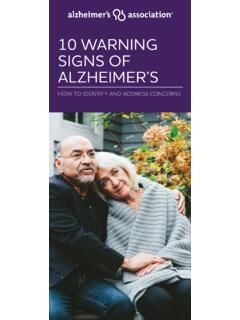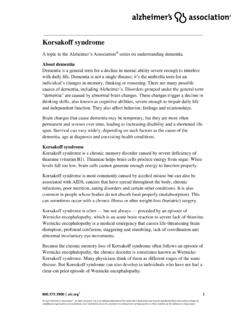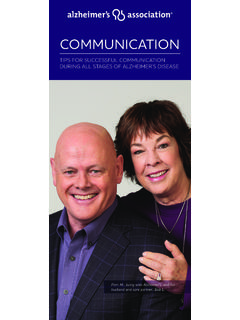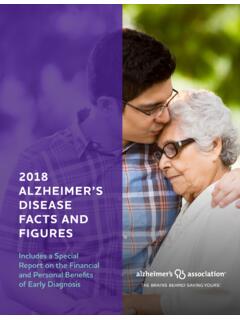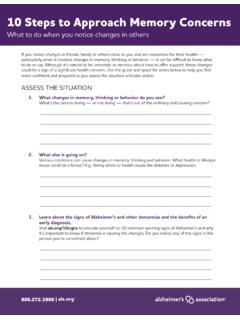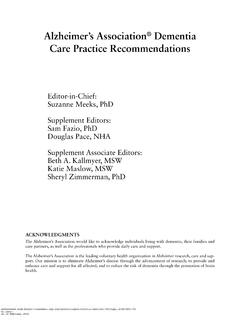Transcription of BASICS OF ALZHEIMER’S DISEASE - Alzheimer's Association
1 BASICS OF alzheimer S DISEASEWHAT IT IS AND WHAT YOU CAN DOGeri T., living with Alzheimer's , and her spouse and care partner, Jim IS alzheimer S DISEASE ? alzheimer s (AHLZ-high-merz) is a DISEASE of the brain that causes problems with memory, thinking and behavior. It is not a normal part of s gets worse over time. Although symptoms can vary widely, the first problem many people notice is forgetfulness severe enough to affect their ability to function at home or at work, or to enjoy DISEASE may cause a person to become confused, get lost in familiar places, misplace things or have trouble with can be easy to explain away unusual behavior as part of normal aging, especially for someone who seems physically healthy.
2 Any concerns about memory loss should be discussed with a alzheimer s DISEASE and other types of dementia .. How alzheimer s affects the brain .. Causes and risk factors .. How to find out if it s alzheimer s DISEASE .. 5. When the diagnosis is alzheimer s .. Stages of the DISEASE .. Treating the Hope for the future .. alzheimer S DISEASE AND OTHER TYPES OF DEMENTIA alzheimer s diseaseMore than 5 million Americans have alzheimer s DISEASE , the most common form of dementia.
3 alzheimer s accounts for 60 to 80 percent of all dementia cases. That includes 11 percent of those age 65 and older and one-third of those 85 and older. The DISEASE also impacts more than 15 million family members, friends and is a general term for the loss of memory and other cognitive abilities serious enough to interfere with daily life. Other types of dementia Vascular dementia is a decline in thinking skills caused by conditions that block or reduce blood flow to the brain, depriving brain cells of vital oxygen and nutrients.
4 These changes sometimes occur suddenly following strokes that block major brain blood vessels. It is widely considered the second most common cause of dementia after alzheimer s DISEASE . Mixed dementia is a condition in which abnormalities characteristic of more than one type of dementia occur simultaneously. Symptoms may vary, depending on the types of brain changes involved and the brain regions affected, and may be similar to or even indistinguishable from those of alzheimer s or another dementia. Parkinson s DISEASE dementia is an impairment in thinking and reasoning that many people with Parkinson s DISEASE eventually develop.
5 As brain changes gradually spread, they often begin to affect 3mental functions, including memory and the ability to pay attention, make sound judgments and plan the steps needed to complete a task. Dementia with Lewy bodies is a type of progressive dementia that leads to a decline in thinking, reasoning and independent function due to abnormal microscopic deposits that damage brain cells. Huntington s DISEASE dementia is a progressive brain disorder caused by a defective gene. It causes changes in the central area of the brain, which affect movement, mood and thinking skills.
6 Creutzfeldt-Jakob DISEASE is the most common human form of a group of rare, fatal brain disorders known as prion diseases. Misfolded prion protein destroys brain cells, resulting in damage that leads to rapid decline in thinking and reasoning as well as involuntary muscle movements, confusion, difficulty walking and mood changes. Frontotemporal dementia (FTD) is a group of disorders caused by progressive cell degeneration in the brain s frontal lobes (the areas behind the forehead) or its temporal lobes (the regions behind the ears).
7 Normal pressure hydrocephalus is a brain disorder in which excess cerebrospinal fluid accumulates in the brain s ventricles, causing thinking and reasoning problems, difficulty walking and loss of bladder control. Down syndrome dementia develops in people born with extra genetic material from chromosome 21, one of the 23 human chromosomes. As individuals with Down syndrome age, they have a greatly increased risk of developing a type of dementia that s either the same as or very similar to alzheimer s Korsakoff syndrome is a chronic memory disorder caused by severe deficiency of thiamine (vitamin B-1).
8 It is most commonly caused by alcohol misuse, but certain other conditions can also cause the syndrome. Posterior cortical atrophy (PCA) is the gradual and progressive degeneration of the outer layer of the brain (the cortex) located in the back of the head (posterior). It is not known whether PCA is a unique DISEASE or a possible variant form of alzheimer s HOW alzheimer S AFFECTS THE BRAINThe changes that take place in the brain begin at the microscopic level long before the first signs of memory goes wrong in the brain The brain has 100 billion nerve cells (neurons).
9 Each nerve cell connects to many others to form communication networks. In addition to nerve cells, the brain includes cells specialized to support and nourish other cells. Groups of nerve cells have special jobs. Some are involved in thinking, learning and memory. Others help us see, hear, smell and tell our muscles when to cells operate like tiny factories. They receive supplies, generate energy, construct equipment and get rid of waste. Cells also process and store information and communicate with other cells. Keeping everything running requires coordination as well as large amounts of fuel and believe alzheimer s DISEASE prevents parts of a cell s factory from running well.
10 They are not sure where the trouble starts. But just like a real factory, backups and breakdowns in 5one system cause problems in other areas. As damage spreads, cells lose their ability to do their jobs and, eventually, role of plaques and tangles The brains of individuals with alzheimer s have an abundance of plaques and tangles. Plaques are deposits of a protein fragment called beta-amyloid that build up in the spaces between nerve cells. Tangles are twisted fibers of another protein called tau that build up inside autopsy studies show that most people develop some plaques and tangles as they age, those with alzheimer s tend to develop far more and in a predictable pattern, beginning in the areas important for memory before spreading to other do not know exactly what role plaques and tangles play in alzheimer s DISEASE .
